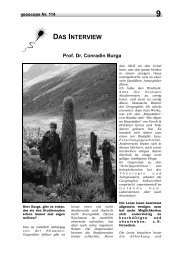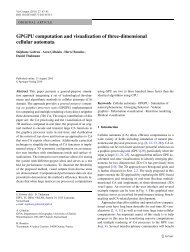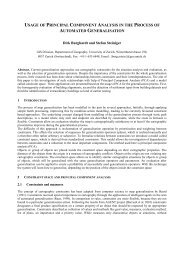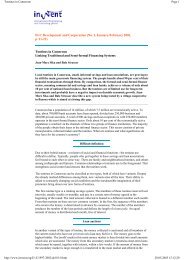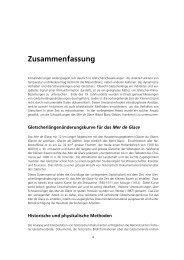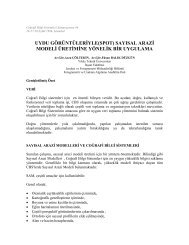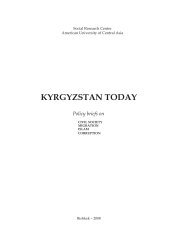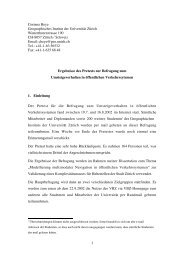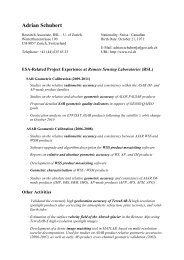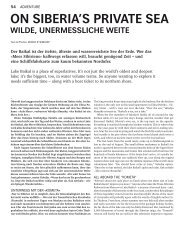Pedogenesis of Chernozems in Central Europe — A review
Pedogenesis of Chernozems in Central Europe — A review
Pedogenesis of Chernozems in Central Europe — A review
Create successful ePaper yourself
Turn your PDF publications into a flip-book with our unique Google optimized e-Paper software.
290 E. Eckmeier et al. / Geoderma 139 (2007) 288–299<br />
<strong>Chernozems</strong> can develop <strong>in</strong> to Phaeozems, and the characteristics<br />
<strong>of</strong> Phaeozems resemble those <strong>of</strong> <strong>Chernozems</strong>. They<br />
have a mollic horizon and a base saturation <strong>of</strong> at least 50%.<br />
They should not conta<strong>in</strong> secondary carbonates up to 100 cm<br />
depth and have no diagnostic horizons other than albic, argic,<br />
cambic or vertic. Compared to <strong>Chernozems</strong>, Luvic Phaeozems<br />
occur <strong>in</strong> more humid regions, have higher rates <strong>of</strong> leach<strong>in</strong>g and<br />
therefore lack carbonates. Argic B horizons seem to be relics<br />
from stronger leach<strong>in</strong>g and <strong>in</strong>dicate the development towards<br />
Luvisols (FAO/ISRIC/ISSS, 1998; Driessen et al., 2001). However,<br />
the soil map <strong>of</strong> the world mentions the subunit Calcaric<br />
Phaeozem with more then 2% CaCO3 (FAO-UNESCO, 1981).<br />
The def<strong>in</strong>itions <strong>of</strong> <strong>Chernozems</strong> and Phaeozems by FAO-WRB<br />
stress their morphology but were biased by the climo-genetical<br />
background. This makes it difficult to assign all <strong>Central</strong><br />
<strong>Europe</strong>an Chernozem subunits (e.g. for Germany described by<br />
Ad-hoc-AG Boden, 2005; see also Altermann et al., 2005)tothe<br />
FAO-WRB classification. The differences between the soil units<br />
described <strong>in</strong> the German pedological literature are expla<strong>in</strong>ed <strong>in</strong><br />
Fig. 1.<br />
Stagnic and Gleyic Phaeozems developed under different<br />
conditions than soils <strong>in</strong> steppe areas (Scheffer and Meyer,<br />
1965). However, the German def<strong>in</strong>ition <strong>of</strong> a ‘Schwarzerde’<br />
(black earth) subsumes soils with greyish to black (Chromab3.5,<br />
Value≤4) Axh horizons≥40 cm and either with secondary<br />
carbonates (‘Kalktschernosem’)orwithout(‘Tschernosem’). The<br />
term ‘Tschernosem’ <strong>in</strong>cludes not only Chernozem or Phaeozem<br />
subunits but also Kastanozems, Gleysols and Fluvisols and<br />
implies bioturbation as specific formation qualification (Ad-hoc-<br />
AG Boden, 2005). Despite these def<strong>in</strong>itions, the terms<br />
‘Schwarzerde’ and ‘Tschernosem’ were usually related to the<br />
appearance <strong>of</strong> steppe soil relics <strong>in</strong> <strong>Central</strong> <strong>Europe</strong>, and therefore<br />
<strong>Chernozems</strong> or Phaeozems (Kossowitsch, 1912; Hohenste<strong>in</strong>,<br />
1919; Wilhelmy, 1950; Altermann and Mania, 1968). Their dark<br />
colour was assumed to orig<strong>in</strong>ate from humic acids coat<strong>in</strong>g clay<br />
m<strong>in</strong>erals that form stable dark complexes (e.g. Laatsch, 1938;<br />
Rochus, 1979; Mückenhausen, 1985a). Kahle et al. (2002) found<br />
that Chernozem organic matter accumulates <strong>in</strong> the clay fractions<br />
and seems to be associated with the m<strong>in</strong>eral phase.<br />
3. Where do we f<strong>in</strong>d <strong>Chernozems</strong> and Phaeozems <strong>in</strong><br />
<strong>Europe</strong>?<br />
The distribution <strong>of</strong> <strong>Chernozems</strong> and Phaeozems <strong>in</strong> <strong>Central</strong><br />
<strong>Europe</strong> is shown <strong>in</strong> Fig. 2. The Eurasian Chernozem occurs <strong>in</strong><br />
an area stretch<strong>in</strong>g from the Southern Urals to the Ukra<strong>in</strong>e,<br />
pass<strong>in</strong>g through Moldavia and narrow<strong>in</strong>g <strong>in</strong> the Danube bas<strong>in</strong><br />
(FAO-UNESCO, 1981; Bronger, 2003). <strong>Chernozems</strong> were<br />
characterized <strong>in</strong> Romania (Schönhals et al., 1982), Bulgaria<br />
(Ko<strong>in</strong>ov, 1968), <strong>in</strong> the Alföld and Banat regions <strong>in</strong> Hungary<br />
Fig. 2. Distribution <strong>of</strong> <strong>Chernozems</strong> and Phaeozems <strong>in</strong> <strong>Central</strong> <strong>Europe</strong>. The map shows the follow<strong>in</strong>g varieties <strong>of</strong> <strong>Chernozems</strong> and Phaeozems: Chernic, Calcic and<br />
Vermi-calcic <strong>Chernozems</strong> (black); Luvic <strong>Chernozems</strong>, Stagnic, Luvic and Haplic Phaeozems (dark grey); Calcaric, Gleyic and Calcari-fluvic Phaeozems (light grey).<br />
Data source: Soil Geographical Data Base <strong>of</strong> Eurasia at Scale 1:1000000 (SGDBE) version 2, http://eusoils.jrc.it/wms/Metadata/Somis_metadata.htm; Bundesanstalt<br />
für Geowissenschaften und Rohst<strong>of</strong>fe, 1995; supplemented by E. Gehrt based on own surveys and <strong>in</strong>formation from the different <strong>in</strong>stitutes <strong>of</strong> the German state<br />
geological survey.






